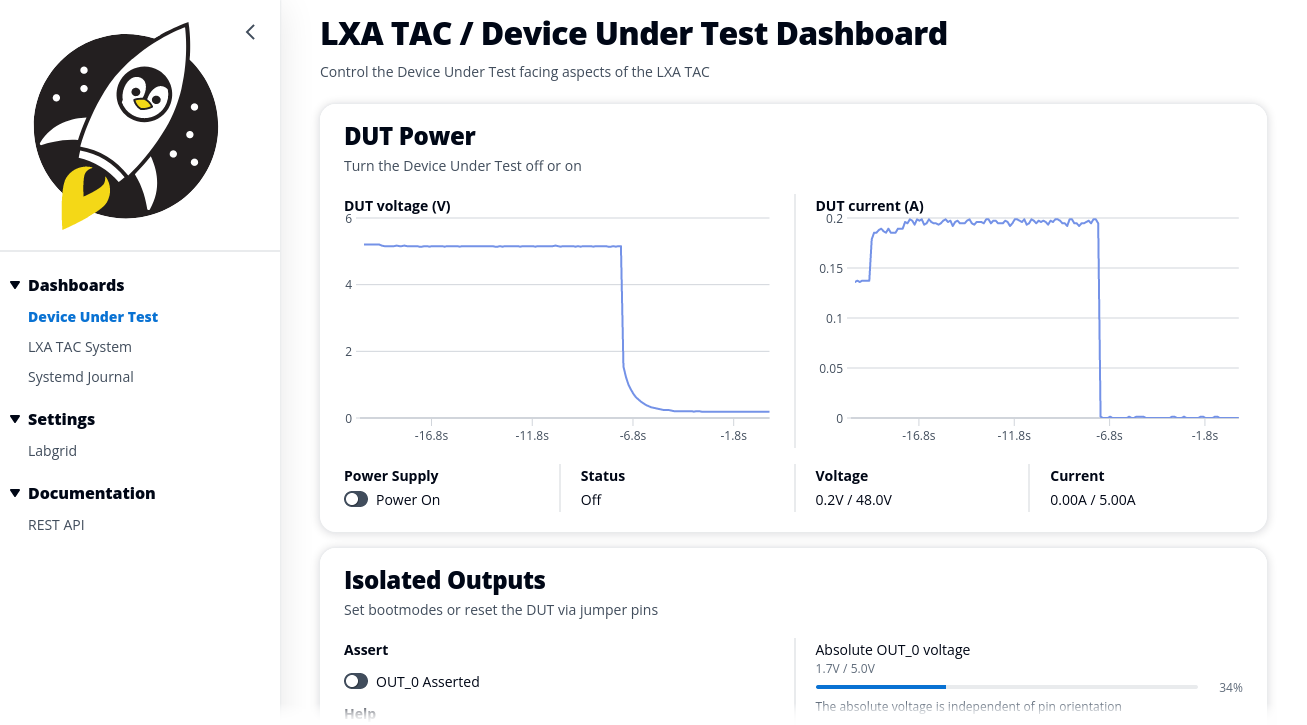This piece of software provides an interface between the hardware of the Linux Automation GmbH Test Automation Controller (LXA TAC) and the user. It runs the interface on the TACs LCD display, as well as the web server. The web server provides an interactive web interface as well as an API for scripting purposes.
We will first have a look on how to build the tacd for your host PC,
as it is easier than building for the LXA TAC itself, then we will go
into how to build for the real hardware.
We do not require a particularly recent version of Rust, so you may have some
luck installing rust and cargo from your distribution's package
repositories. If not you may have to resort to installing via
rustup (which may also be
available from distribution repositories).
We use npm to build the LXA TAC web interface.
You may again have some luck installing it from distribution repositories or
have to resort to installing via curl … | sh as documented in the README
linked above.
The tacd serves a React-Based web interface to interactively remote control
the LXA TAC.
If you want to use this web interface with your tacd build you should build it
from source using the dark witchcraft that is javascript dependency management:
$ cd web
$ npm install .
$ npm run build
The tacd contains stubs that make building a stripped-down version for your
host PC possible. These can be useful for quickly checking if a change
compiles, testing changes in the web interface or running unit tests.
The tacd heavily relies on a lot of hardware and files being present on the
TAC, this means that the full tacd can not run on a non-TAC system.
You can however run a stripped-down version by using:
$ cargo run --features=demo_mode --no-default-features
Note that rust will complain very loudly about a lot of dead code, which is not used when building for PC but used on the TAC.
While the test coverage is not great yet (PRs welcome!) there are some unit tests that can help find regressions. Run them using:
$ cargo test --no-default-features
To cross-compile for the LXA TAC you will need to build and install a cross
SDK. If you only want to test a little patch it may be easier to use the
yocto devtool in meta-lxatac,
instead, which does however have the drawback of longer build times.
To build outside of meta-lxatac you first need to install the respective rust
toolchain:
$ rustup target add armv7-unknown-linux-gnueabihf
Next you will have to build an SDK using meta-lxatacthat includes libiio:
$ bitbake -c do_populate_sdk lxatac-core-image-iio
And install it on your host PC.
To build using the SDK you will have to souce it according to the yocto SDK
documentation and add the following to the .cargo/config.toml:
[target.armv7-unknown-linux-gnueabihf]
linker = "[PATH_TO_YOUR_INSTALLED_SDK]/sysroots/x86_64-oesdk-linux/usr/bin/arm-oe-linux-gnueabi/arm-oe-linux-gnueabi-gcc"
rustflags = [
"-C", "link-arg=-mthumb",
"-C", "link-arg=-mfpu=neon-vfpv4",
"-C", "link-arg=-mfloat-abi=hard",
"-C", "link-arg=-mcpu=cortex-a7",
"-C", "link-arg=--sysroot=[PATH_TO_YOUR_INSTALLED_SDK]/sysroots/cortexa7t2hf-neon-vfpv4-oe-linux-gnueabi",
]
Remember to update both paths so that they point to your installed SDK. Also remember to always source the SDK activation script before building for the LXA TAC (and using a shell without a sourced SDK when building for the host PC).
Then, you can use cargo build --target armv7-unknown-linux-gnueabihf to
compile the tacd.
The resulting binary is placed in target/armv7-unknown-linux-gnueabihf/release/tacd
and contains everything required to run the tacd, including the web interface.
It can thus just be copied to your LXA TAC and run instead of the existing
tacd (remember to systemctl stop tacd the already running instance).
We are always open for outside contributions, just make sure to follow these guidelines:
- Use a somewhat recent stable rust release for testing
- Use
cargo fmtafter every change to the rust codebase - Use
cargo deny check licenseif you have introduced new dependencies to check if they (or their dependencies) introduce license issues. - Use
npx prettier@=3.0.1 --write .(in the web directory) after every change to the web codebase.
